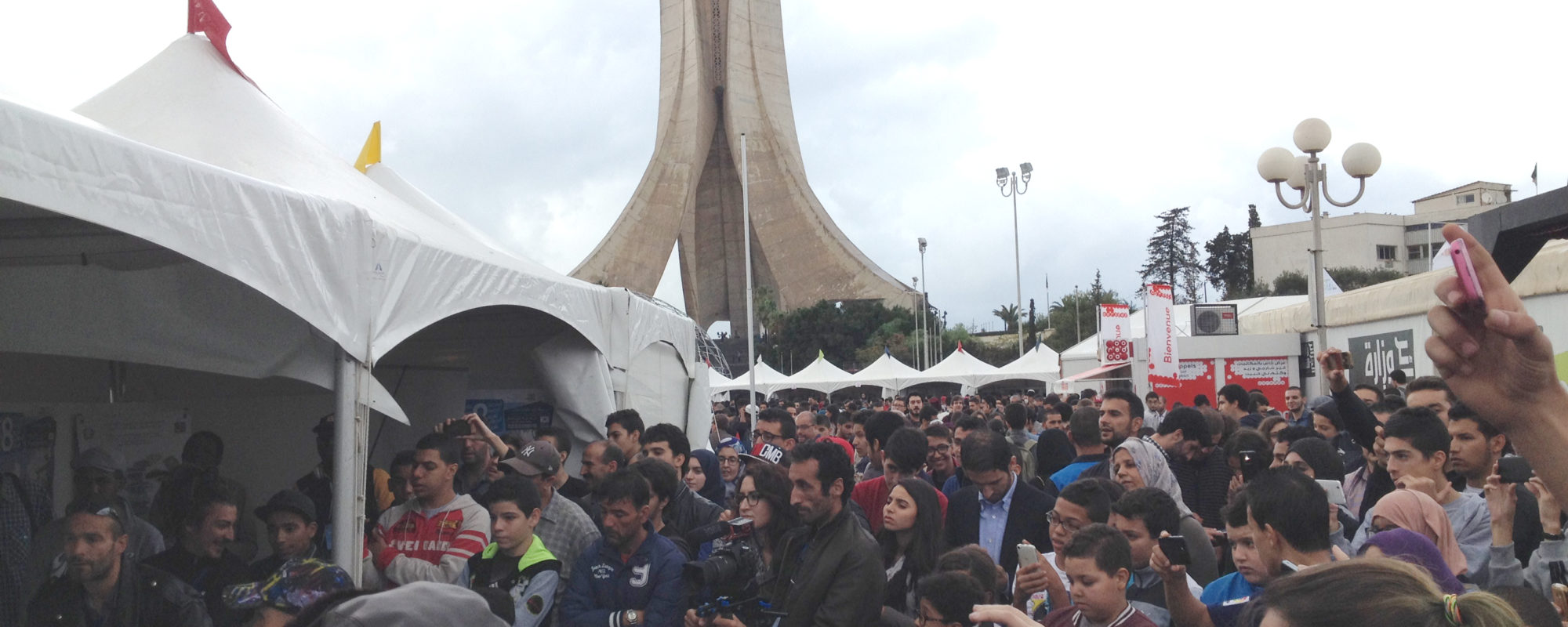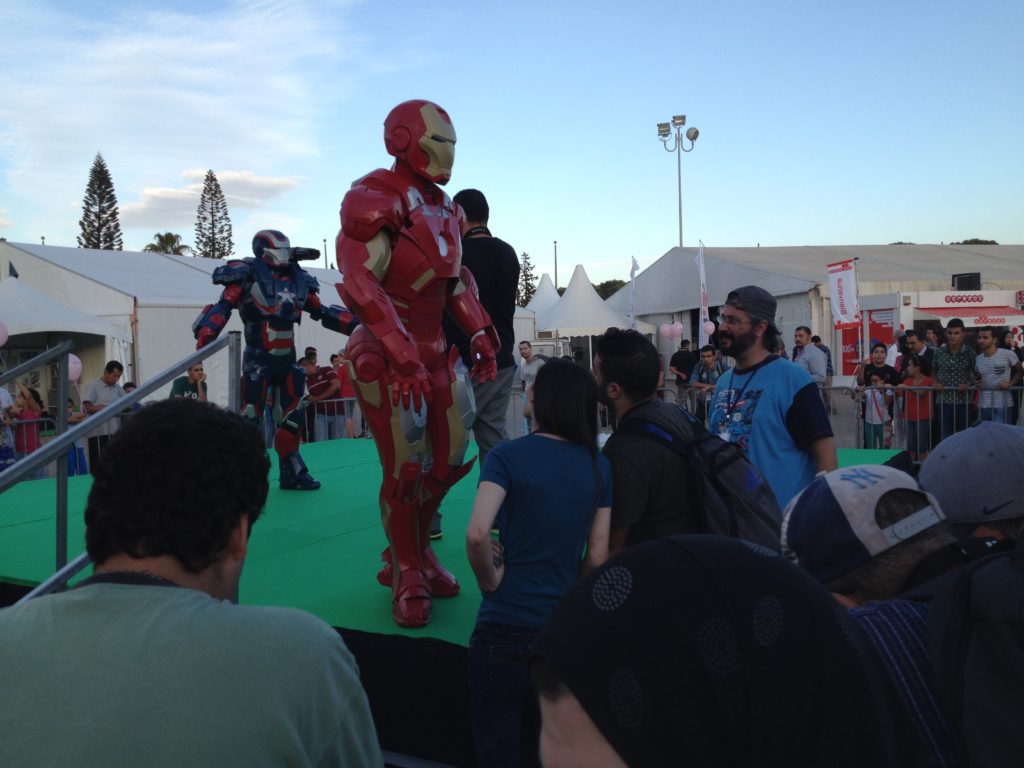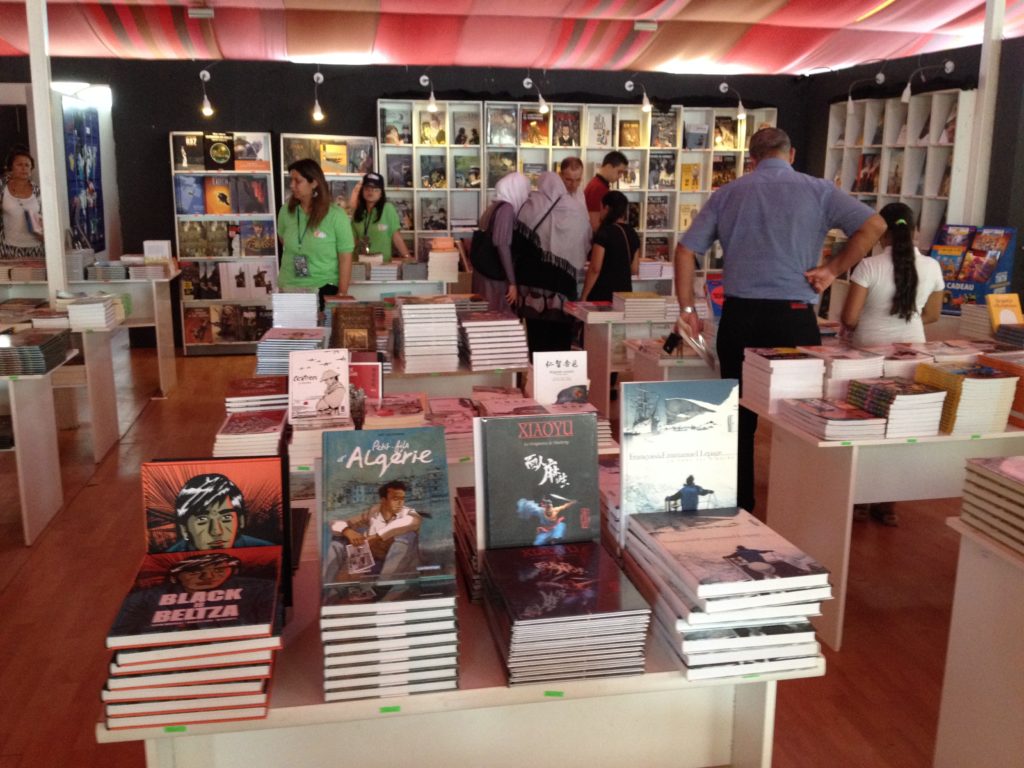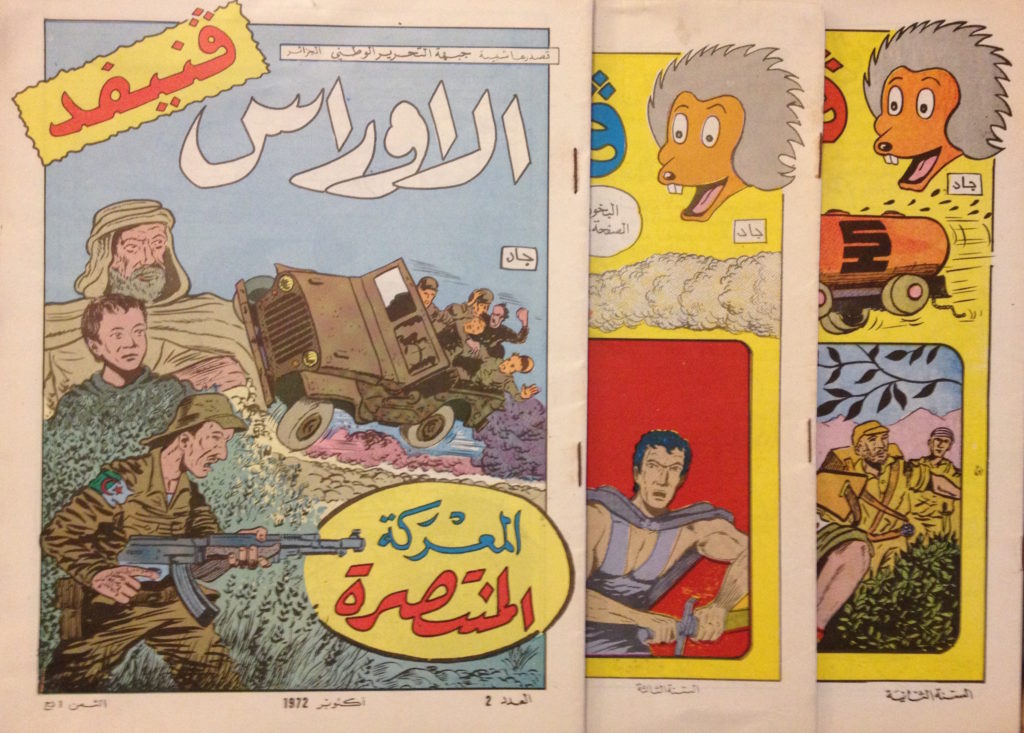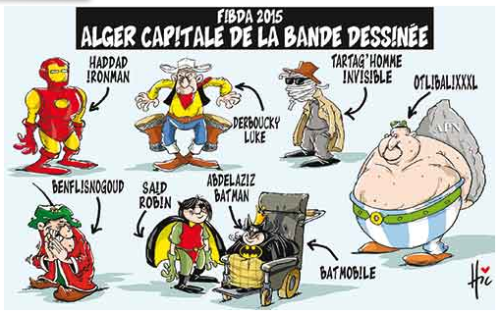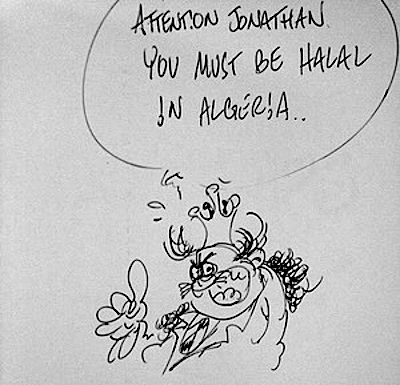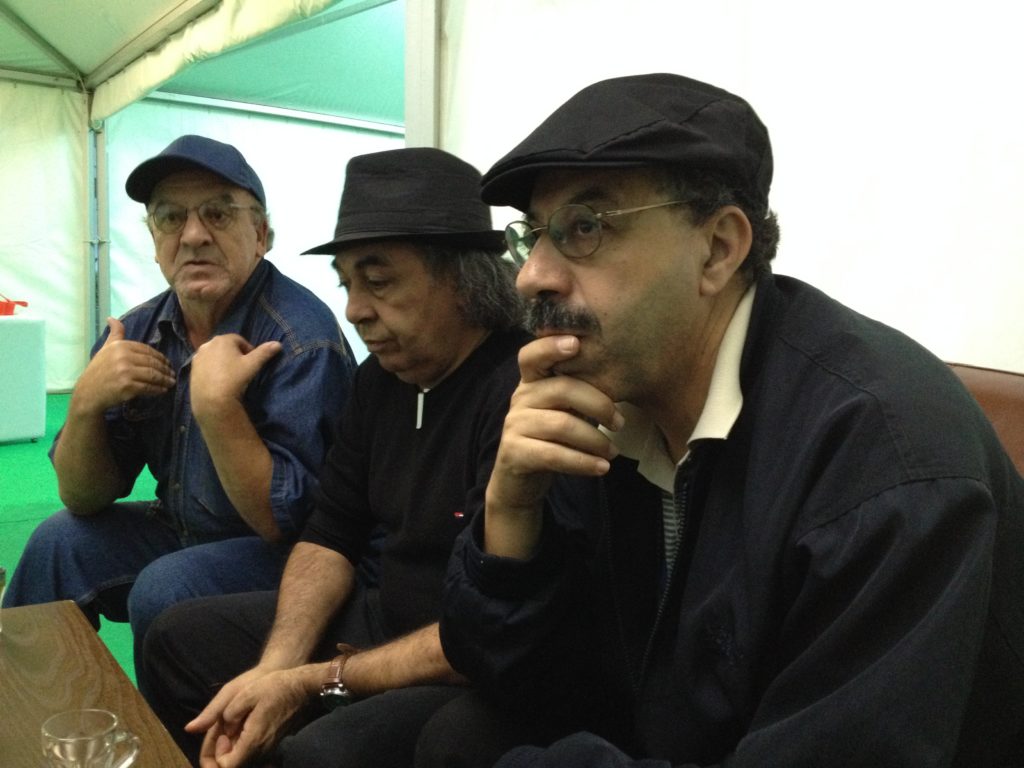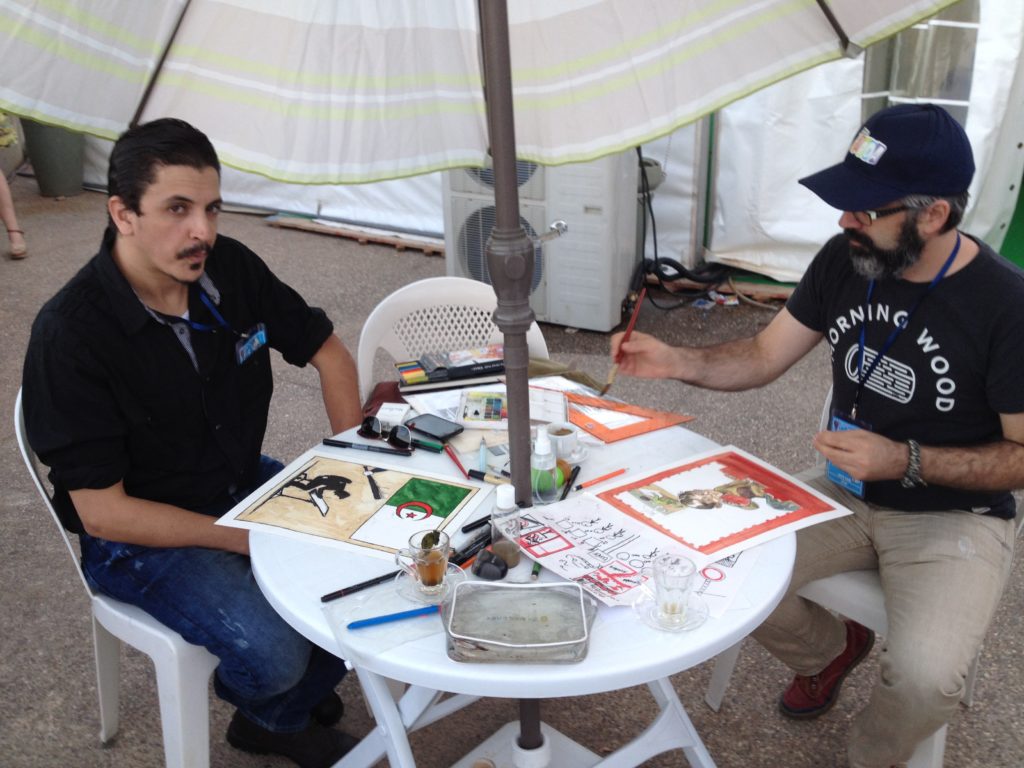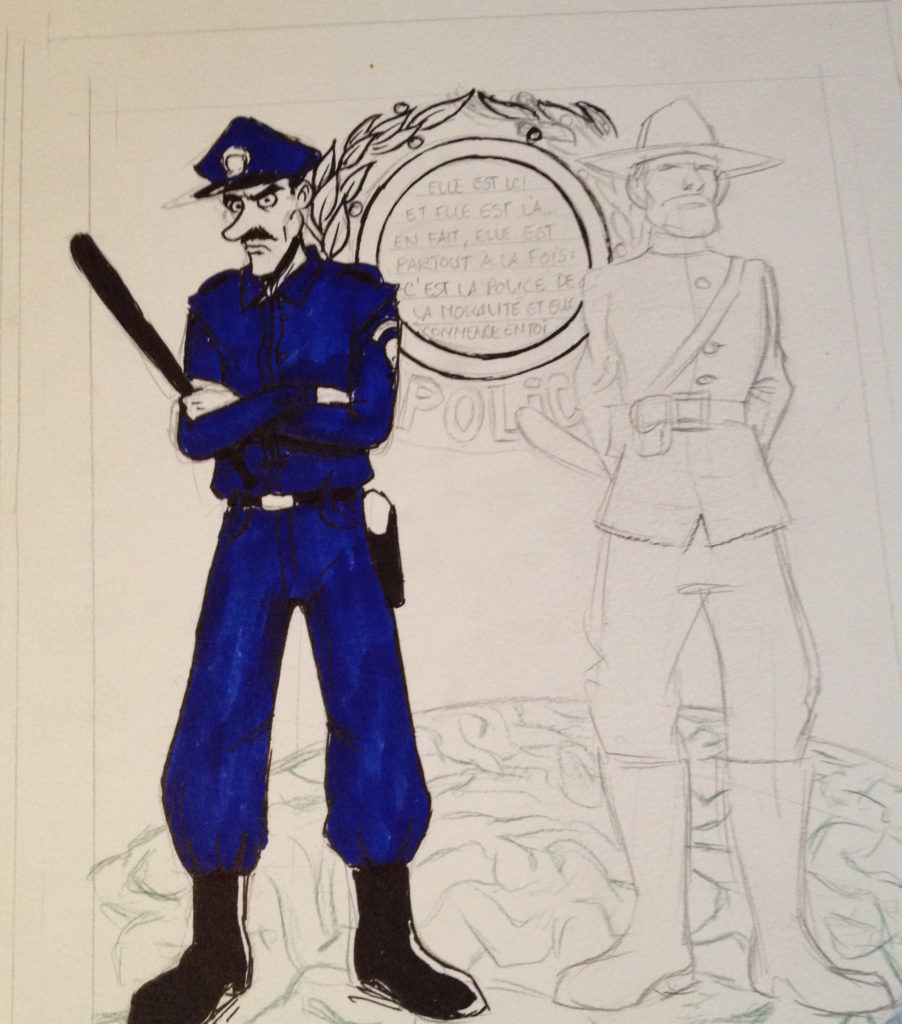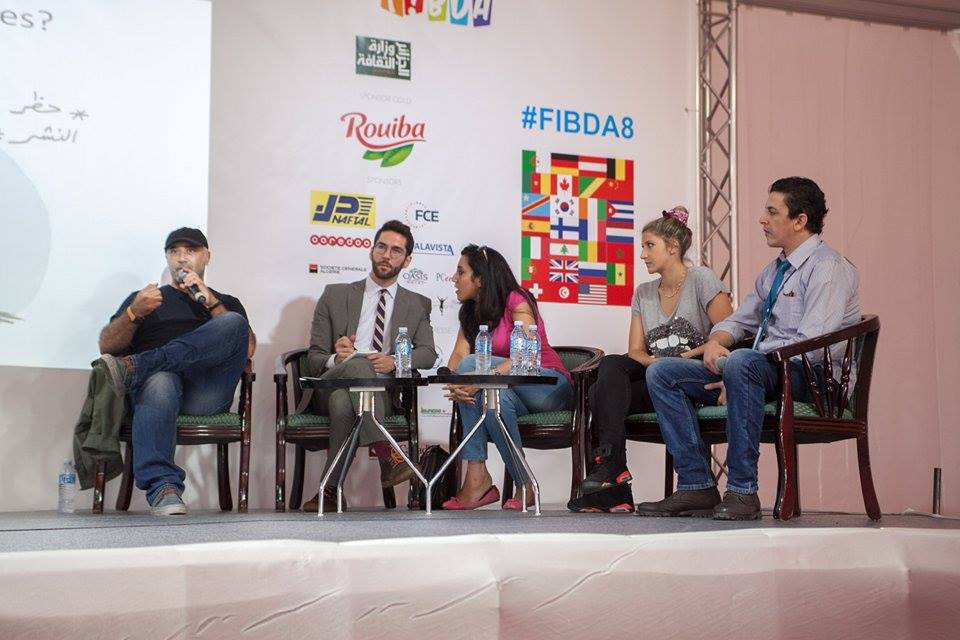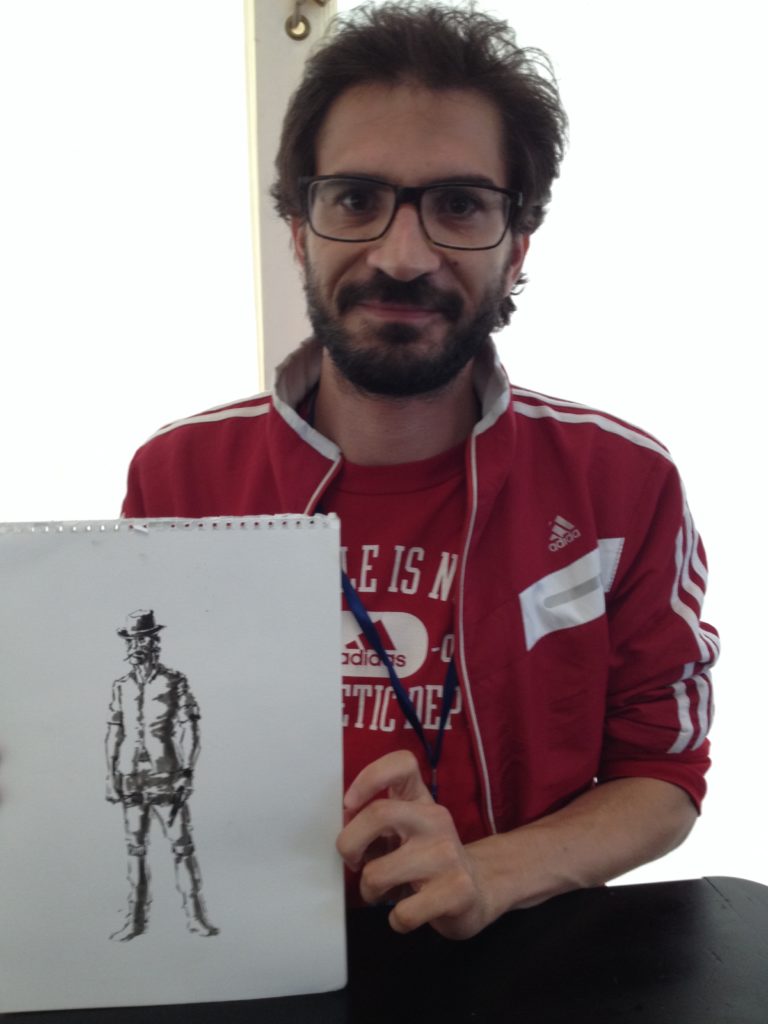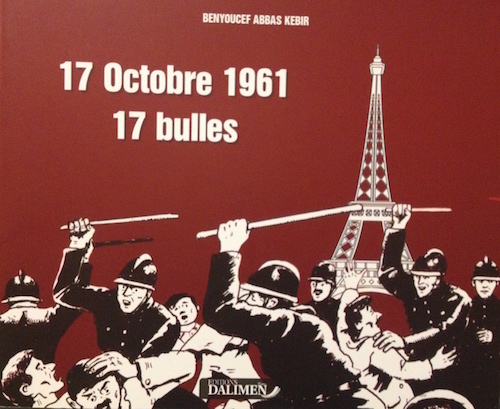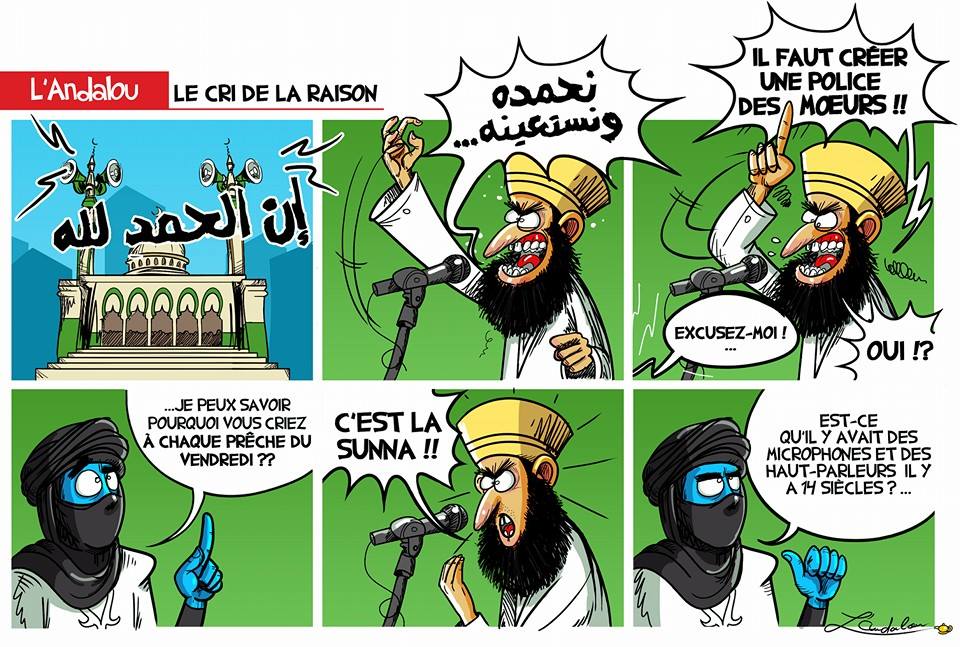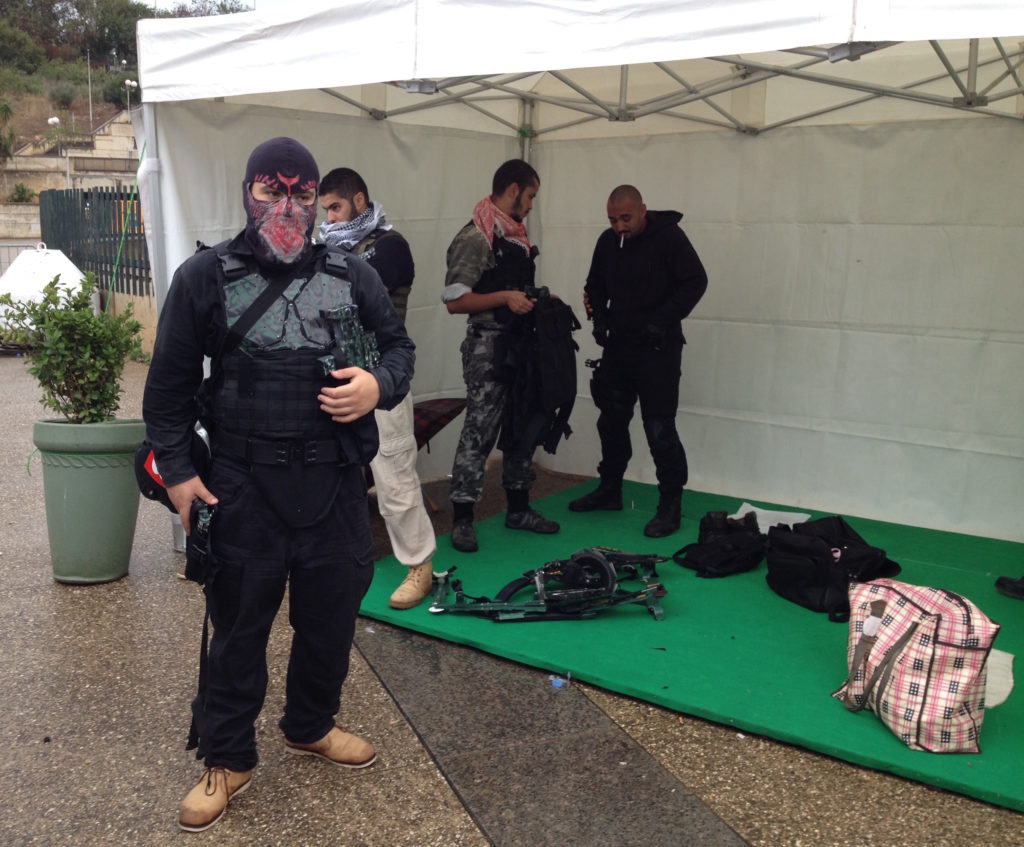12 Nov 2015
Le Festival International de la Bande Dessinée d’Alger is held on hallowed ground. Between the massive Martyrs Monument and the Army Museum, the white tent city of booksellers, exhibitions, plenaries and workshops sits above the hills, upon a multi-floor shopping center of the Esplanade de Riadh El Feth. The Martyrs Monument’s distinctive shape, three concrete palm leaves leaning on each other, forms a brutalist obelisk that can be seen throughout the city. A Gotham-esque silhouette ripped from the pages of Batman, the monument honors the 1962 war of independence from France and the fallen revolutionaries.
Like the tanks and planes outside the Army Museum, FIBDA is a spectacle to be consumed. In convening artists from across the globe, the festival orders the participating countries into hierarchies, similar to a world expo: each guest nation has its own distinct pavilion and its own branding, constituting an internationalism that erases differences between countries and extracts the universality of comics. Despite the enthusiasm from some 80,000 visitors, the cordoned off zone for comic fandom, far from downtown and literally on a government platform, feels like a top-down exercise.
The Algerian Ministry of Culture, “under the patronage of his Excellency Mr. Abdelaziz Boutefklia, President of the Republic,” has modeled the premier comic confab in Africa and the Middle East after the annual French festival for Bande Dessinee in Angouleme. Many Algerian artists at the festival have grafted the French tradition of graphic novels and in drawing anticolonial comic narratives onto their own works. Political cartoonists who deride Algerian state institutions display their frames here, too, in a smaller pavilion. But mostly, the festival is a bubble, where the country’s colonial past is retold as stories of nationalist superheroes for children, packaged and sold in comic books. More contentious topics, such as Algeria’s current relationship with France or violence against cartoonists, do not fit into the funfair’s map or agenda.
Up a steep driveway and onto the esplanade, facing the sea, a guard waves me through the metal detector and into the small comic village. Electronica blares from the loudspeakers. Some teens wear skinny jeans and flannel, and just as many are dressed in costumes—from Captain America to PLO fighters, from gothic to grotesque, from Game of Thrones to their own fantastical characters. The festival provides a rare opportunity for kids to be kids in a city where public cultural events are lacking. School children pile into the workshop tent where they draw on the walls and tables. In empty tents nearby, teens dress up in their faux military regalia, jousting with swords and aiming plastic rifles at each other, as armed security guards protect the facility.
The five-day festival lacks overt political messages, even though this year’s theme is, ironically, freedom of expression. The dozens of events are mostly focused on comic art and craft; only a single workshop on free expression and one panel on comics in the Arab world are held, as if the theme is merely the festival’s costume. Yet FIBDA’s establishment itself eight years prior was a bold expression of political speech.
Algeria’s dynamic and multifaceted history of comic art and political cartoons, mostly penned in French, is just rising from the wreckage of the 1990’s.[i] A boom of comic strip publishing and hundreds of new political periodicals emerged after the 1988 uprising and the subsequent passing of a liberal constitution, which permitted a more independent press as well as political parties.[ii] That short-lived democratic experiment was spoiled, in 1991, when the army cancelled elections that the Islamic Salvation Front was sure to win.
Nearly a decade of civil war followed. The military arrested Islamists; guerilla warfare and assassinations disrupted all aspects of life. Of particular note was Islamist militants’ targeting of intellectuals and secular symbols.[iii] More than 95 journalists were killed, among them humorists and illustrators. In 1994, two bullets struck satirist Saïd Mekbel. A year later, Brahim Guerroui, cartoonist for the official newspaper El Moujahin was kidnapped and executed.[iv] Cartoonist Mohamed Dorbane was killed by a car bomb set outside his offices, in 1996, which killed 15 others. Most comic artists went underground or fled the country. The state also restrained speech. In 1996, Chawki Amari drew a cartoon for La Tribune of political elites holding a flag, referred to as “dirty laundry.” Authorities arrested him for three weeks for “insulting the flag.” Hundreds protested his arrest as the newspaper was shuttered for six months. “There was a break in comics during the black decade,” says Kamal Zakour, a 35-year-old Algerian illustrator and children’s book artist. “It started again with FIBDA,” says Zakour.
“Magazines by White Men for Little White Men”
In 2008, the Ministry of Culture launched the festival to revive the Algerian comics scene, an investment that has expanded readerships and audiences.[v] Before FIBDA only one publishing house in Algiers focused on sequential graphic art. Today at least seven print scores of personal memoirs and historical narratives, along with new comic magazines, Manga serials, political cartoon monographs, and nationalist narratives for kids.
South Korea is the festival’s guest of honor, with a giant tent displaying comic art of silly anime and long mural-like strips, all of which are incomprehensible but stunning. Amid wall-to-wall cosplay (costume play), I spot the American Ambassador to Algiers, Joan Polaschik, licking an ice cream cone at the entrance to the Korean exhibition, as four guards scan the crowds. When I introduce myself and explain that I research comics in Cairo, Polaschik notes that many critical cartoons appear in the independent press, an indication of a robust media. “Algeria gets a bad rap for human rights,” she tells me.
China also has its own tent, with traditional illustrations and calligraphy. Two artists draw portraits in the center, as dozens line up. The next pavilion over comprises an extensive bookshop, everything from the ultra-violent to the ultra-pedantic, neatly set on white tables and shelves with lime green price stickers. Among the thousands of volumes: monographs from Africa, East Asia and Europe; shelves of local Manga series; a 20-volume Arabic and French comic about Algerian history; Western superheroes translated to French and Islamic superhero stories originally written in French; bio-comics of Jean-Paul Sartre and Paul Klee—and only a handful of books in Arabic.
FIBDA bestows this year’s grand prix on the Algerian illustrator Redouane “Red One” Assari, exhibiting his intricate frames of cars and cityscapes in an inflated white dome in the festival ground’s center. But the grandest exhibition spaces are reserved for visiting artists from East Asia. Arab countries are barely represented. Is it an attempt to show that Algeria today has the convening power to exhibit the finest graphic artist globally? Or an avoidance of the more politically charged comics that have emerged across the Arab World and comment directly on democracy, corruption and terrorism, issues that might resonate in Algiers? My first impression is that there is little specifically Arab about the festival. I also sense a dissonance between an undemocratic government and its organizing an event around the theme of free expression. My goal is to find the young Arab artists here and ask them what they think.
I walk out of the fairgrounds and down a flight of concrete stairs to find a restroom. I pass a door labeled Cercle Frantz Fanon, a social club named for the critical theorist and spokesman for the Front de Libération Nationale. Fanon argued for the right of colonized people to violently revolt against oppressors. One of the oppressor’s techniques to subjugate black people, which Fanon noted in his book Black Skin, White Masks, is comics:
The Tarzan stories, the sagas of twelve-year-old explorers, the adventures of Mickey Mouse, and all those “comic books” serve actually as a release for collective aggression. The magazines are put together by white men for little white men. This is the heart of the problem. In the Antilles—and there is every reason to think that the situation is the same in the other colonies—these same magazines are devoured by the local children. In the magazines the Wolf, the Devil, the Evil Spirit, the Bad Man, the Savage are always symbolized by Negroes or Indians; since there is always identification with the victor, the little Negro, quite as easily as the little white boy, becomes an explorer, an adventurer, a missionary “who faces the danger of being eaten by the wicked Negroes.” I shall be told that this is hardly important; but only because those who say it have not given much thought to the role of such magazines.[vi]
This vilification of black people still appears on newsstands globally, in Marvel comics’ orientalization of Muslims, for instance, as well as in Charlie Hebdo caricatures of African migrants. Yet in the half-century since Fanon wrote about how colonial perspectives were enshrined in pop culture, a canon of anticolonial comics has emerged. Algerian comic artists have flipped the binary described by Fanon, as they disseminate new forms of “collective aggression” that disparage the West and glorify the 1962 revolution. Comic magazines by Algerian men for little Algerian men construct revolutionary heroes, such as the children’s comic series Vinifred, first published in the 1970’s and available in a special tent at FIBDA. It’s part of an ongoing genre of didactic, nationalist comics that paints the French as evil Goliaths and the Algerians as valiant Davids. (Israel, represented as an evil wombat, and the West, an aloof ostrich, try to steal oil from Algeria in the 1972 issue.) “The victorious battle” of Algerians versus the French is illustrated in formal Arabic, like a history textbook. This narrative may have once been revolutionary; now it has been institutionalized, closely approximating the displays in the neighboring Army Museum.
“You Must Be Halal in Algeria!”
The festival’s official photographer, Said Ait Ali Said, graciously guides me through a small exhibition tent, featuring five Algerian cartoonists. Occasionally snapping a photo with his SLR, he offers me a brief history of the men in question, translates the French text, and explains local jokes.
A buff and shirtless He-Man graces one wall—the Algerian artist Ali Moulay’s 1980 depiction of Jurgurtha, the Numidian king who rose to power in the first century BC and battled Rome, a veiled retelling of the 1962 war of liberation against France. It faces a sequence of illustrations from Benyoucef Abbas Kebir’s 17 October 1961, 17 Bulles, a 2011 black-and-white graphic novel that commemorates the slaughter of pro-Algerian demonstrators in Paris at the hands of French authorities. Across from that are Gyps’s comic strips, typical of the sexist gags found in the pages of Playboy or Private Eye, many of which lampoon piety and feminism. In the next room, Cuban comic art is shown and a short documentary about Havana plays on a loop. The French artist Joel Alessandra’s memoir of his search for his family history in Algiers is in the adjacent hall. Around the corner, a realistic portrait of President Abdulaziz Bouteflika, drawn by the cartoonist Beneddine, hangs amid the raunchy cartoons and magazine covers. The big man is present, without the mockery typically found in caricature. Taken together, the gallery encapsulates the Algeria of the popular imagination, of resistance, freedom fighting, and third worldism, with the generous portrait of the president signifying a dissonance within the national narrative.
Tucked in the back, at the entrance to a small comic reading room, is a poster of cartoons by Le Hic, who has been illustrating for over two decades, most recently for the independent El-Watan newspaper. His most hard-hitting commentary about Algeria is not displayed here but rather cartoons about Chinese repression, the falling U.S. dollar, and the migrant crisis.
Past the raucous techno music and hordes of teens masked and made up as archers, boxers and other avengers, Said and I stroll to the VIP tent. Inside, a group of European cartoonists sit on black leather couches around a table with pink and red roses. Everyone is drawing everyone, in charcoal, sharpies, and watercolors.
The first person I meet is Le Hic himself, who wears a baseball hat, smokes a cigarette, and prefers to speak in French rather than Arabic. I pull out today’s El-Watan from my bag, and together we look at his one-frame cartoon that celebrates FIBDA. He caricatured local heroes and anti-heroes, all in well-worn uniforms: Haddad Ironman (the tycoon Ali Haddad), Debhouky Luke (the musician-cum-president of the National Liberation Front), Tartag Homme Invisible (head of the military intelligence agency Athmane Tartag), Benflisnogoud (the former prime minister Ali Benflis), OtlibalXXL (the corpulent president of Congress as Obelix), Said Robin (the president’s sidekick), and Abdelaziz Batman (the president), whose “Bat Mobile,” is a wheelchair.
In office since 1999, Abdelaziz Bouteflika suffered a stroke in 2013 and is now confined to a wheelchair and scarcely seen in public. Despite restrictions and risks, cartoonists ruthlessly mock the president and his disability. Le Hic has grown notorious for eight trials he has encountered for defamation; he recalls going to court every Wednesday for two years only to receive a three-month suspended sentence in 2005 for insulting the president.
Among the Algerian cartoonists most famous for flaunting rules is Ali Dilem, who is now based in Paris and continues to draw for the Algerian paper Le Liberté. (He has been drawing for Charlie Hebdo since February, though there has not been any pushback against him for being associated with a publication known for blaspheming the prophet.) His critical cartoons led to the so-called Dilem Amendment, a 2001 addendum to the penal code that prohibits insulting the president and state institutions, holding out a maximum of two years in prison for violations. Dilem himself has been prosecuted more than 50 times and served a year in prison in 2003. Several lesser known cartoonists have been arrested due to the prohibition, most recently Djamel Ghanem, who was arrested and acquitted for an unpublished cartoon, and then fled to Paris in 2014.
The country is an efficient if not ruthless police state, according to NGO reports, but in practice the Ministry of Culture lends a soapbox to opposition cartoonists. Books by Dilem, Le Hic, and other dissenting cartoonists are on sale in a tent across from the administration office. Le Hic sits autographing books for a queue of fans. In my copy of his collection of press illustrations Printemps Halal, he inscribes a warning from a crown-donning, wispily mustachioed Bouteflika, “Attention, Jonathan: You must be halal in Algeria!”
Ifaz Matoub, the festival’s art director, tells me, “[Le Hic] is the most important cartoonist in the country,” before whisking me to the press tent, for a live interview with Radio El Bahdja. Sitting in a circle of leather couches with cartoonists from China, Cuba, Italy, Korea, Russia, and Spain, I meet two Algerian artists who were among this year’s winners of the festival’s prix de partimoine: Beneddine, 60, and Ali Moulay, 61.
That afternoon, in the VIP tent, Abbas Kebir (in a newsboy cap), Bennedine (in a black fedora), Moulay (in a baseball hat) and I (hatless) sip mint tea and talk shop. “We were the first country in the Arab World who gained freedom of expression by the late eighties,” Abbas Kebir tells me in Arabic. “Starting from 1988 and 1989, Arabic and French newspapers emerged. We had freedom of expression.” He recalls that the president began to appear in caricatures in 1990, with the establishment of new satirical magazines. Beneddine agrees and describes the ubiquity of self-censorship during the single-party system, before ’88, and the flood of dissent that followed.
The three comic artists nod when I ask whether today the media enjoys broad freedoms. “Yes, there is freedom of expression in print media and cartoons,” says Kebir. “Journalists enjoy freedom of expression. There is just a media law in case journalists exceeded their limits in freedom of expression. There are limits for freedom. If you exaggerate in criticizing someone, you must have a proof—not because you are just criticizing. The same applies to cartoonists. Cartoonists can criticize, but there is a limit.” Then some French cartoonists join us, and the conversation shifts to pleasantries.
“The Morality Police”
Outside of the VIP tent on a private terrace, two cartoonists sit at a white picnic table scattered with brushes, pens, and papers. They are planning a workshop on free expression. Wearing black Ray Bans on the cloudy humid evening, L’Andalou—a young cartoonist for the private newspaper El-Watan Weekend, whose pen name comes from the conquistador from southern Spain—sits with Canadian illustrator Simon Depuis.
L’Andalou tells me that censorship and its attendant problems are “always with the people, not the government,” explaining that vocal nationalist readers often push back against his cartoons. “Religion is a very difficult [issue],” he says but he continues to draw bungling fundamentalists misusing their religious power or ISIS militants stamped with swastikas. As for government censorship, “They know if they imprison one of us, they will make publicity [for us],” he tells me. L’Andalou has a sense of humor about it all. His book, Welcome to Algiers, a compilation of his published political cartoons, begins with a dedication to friends and colleagues, followed by the names of Bouteflika and Prime Minister Sellal. It must be a joke, given that the first comic in the volume shows Bouteflika at the podium at three instances—in 1999, 2004, and 2009. Each year, the president calls for stability, as he grows grayer and ends up in a wheelchair. Beside him, a checklist of the country’s ills: “injustice; corruption; brain drain; capital drain; riots; financial scandals…”
Censorship comes in a variety of forms. Dupuis and L’Andalou’s original idea was to host the workshop in memory of Alan Kurdi, the Syrian infant who washed up on a beach in Turkey this September, perturbed by the needless death of refugees. The Canadian Embassy, however, did not welcome such activism a week before their federal elections and in light of increased attention toward Canada’s unfriendliness to Mideast refugees. Dupuis feared that the Embassy would cancel his flight if they went ahead with this idea, and Embassy officials were planning to attend the workshop. So the two cartoonists change course, instead focusing on how children are conditioned to limit their scope of thinking from birth. They draw a six-page comic together, which the rest of the workshop participants would use as a launching point.
The first image, labeled “The Morality Police,” is of a Canadian Mountie and a cross-armed Algerian policeman standing atop a brain. Dupuis inks the next illustration, a child building his own Lego cage and thus hemming himself in. “As a child you are taught to fit into a frame,” he tells me, referring to self-censorship in his hometown Quebec. L’Andalou dips his brush into a porcelain espresso cup for a rinse and then sweeps watercolor on the backdrop of the next sheet: An Algerian flag covers the top half; below, the silhouette of a cartoonist at the drawing board as the blue-uniformed sleeve of a policeman gripping a baton hovers over his head. I notice that next to his palette and cigarettes is the original sketch, in which a machine gun—rather than a baton—intimidates the cartoonist. The dichotomy of the gun versus the pen is too harsh for this audience.
An hour later, I ride a taxi to Algiers Centre to meet former ICWA Fellow Hannah Armstrong for dinner. We cross palm-lined avenues; traffic is heavy but flows easily, as drivers respect traffic signals and policemen. I’m texting and tweeting as the car stops just behind an armored police van on Dedouche Mourad Street, the central downtown thoroughfare, in what I figure is stop and go traffic. Then I hear screams. I look across the windshield. In the next lane, a few meters away, four black-uniformed Central Security Force men pull a twenty-something-year-old driver out of his small hatchback. One riot policeman punches him, then another, then another. As onlookers rush over to watch the scene, mostly in silence though a few are laughing, another half-dozen security forces appear from my periphery vision. They wield batons. I feel every blow. Hard ones. They pull the driver from the ground, open the back doors of the black van and throw him in. Several policemen jump in, batons in hand. This action film is unfolding before my eyes. I know that as a foreigner, there is nothing to be said or done.
The victim’s hatchback sits parked, as the police van starts down the street and the cab I’m in follows, until the vehicles part ways on the next block. Three years in Egypt and across the Middle East, and I have never seen such a wanton attack on a civilian. When I ask the driver what happened, he responds, “The law above all.” He continues speaking in a mix of French and Algerian Arabic, saying that the guy had probably not stopped at a checkpoint. My survival instinct represses the violent incident until, over rice and beans with Armstrong and a Western Saharan diplomat, the thuds of the batons resurface. I convey the story. Both of them, who have lived on and off in Algiers for years, are surprised. They say they’ve never seen any violence of that caliber, that the police are known for being restrained.
With that incident in mind, I am surprised a couple of days later when Le Hic tells an audience of hundreds, “In Algeria, there is free speech.” Perhaps there is, but an open press is only one aspect of a democracy. Le Hic, L’Andalou and I sit together on the conference hall’s stage for a panel discussion, “Say It in Bubbles: Comics in the Arab World,” moderated by broadcast journalist Ahmed Lahri. The plenary is lined with comic art: frames from Joe Sacco’s illustrated journalism, Palestine; a series of Western African cartoonists that is headlined with the Arabic phrase, “We Are All African”; European comic narratives about Algeria; futuristic images of Algiers by Italian comic artist and painter Virginio Vono. Speaking to a full crowd, we talk about cartooning as journalism, about the unique red lines in Egypt versus Algeria. L’Andelou says that it’s hard to be an Arab cartoonist, especially because travel to many Arab countries requires difficult to obtain visas. He adds that he has no problems in general with publishing recalcitrant illustrations. “We have to laugh at our problems,” says Le Hic.
I can’t bring myself to laugh at the assault on that driver in downtown Algiers. I had always thought that cartoons hold out the power to avenge injustice through nonviolent means, until I had witnessed a senseless beating. Now I wonder if illustrations are a form of escapism, a creative realm where the wronged can imagine retribution in speech bubbles that have little impact on real life.
“Self-Censorship is Our National Identity”
When the rain pours, the tents of FIBDA leak. I duck out and spend an hour in the military museum, perusing dioramas of the anti-French uprising and bronze busts of martyrs. Back in the VIP tent for a shot of espresso, I befriend Mohamed Walid Grine, one of the festival’s official translators. He gives me a list of used bookstands and iconic booksellers, such as Librarie du Tiers Monde, downtown. He tells me of a collection of short stories he had written in French; the Algerian publisher told him he had to withdraw one of the stories, about sexual repression and the difficulties of marriage, if he wanted to print it. Walid shelved the entire project.
We walk out of festival grounds and into the adjacent concrete shopping mall to Massinissa café, named after the founder of the Numidian kingdom in Constantine in the second century BC. In the smoky hideaway, scenario writer Abir Gasmi and artist Moez Tabia join us. The two Tunisians are co-authors of the 2014 wordless graphic novella Oblation, in which a child leaves home with her amputated and headless teddy bear. Wandering through a dark world of violence, the nameless protagonist runs and swims, faces off against guns and ghosts, soldiers and dark angels, only to land in a green field with a giant tree, where her stuffed animal’s head magically reappears. Gasmi describes Oblation as “about the whole situation in the Arab World, something more universal: the situation of children in war zones in general.” Oblation is not on sale at the festival’s shop; Gasmi and Tabia’s names are absent from the schedule or slickly printed catalog.
I ask them if they share my hesitations about the festival’s colonial undertone. “I don’t like that they are focused on France. It’s an Arab festival. Communication between Arabs is important and needs to be stronger,” says Tabia, wearing a red Adidas track jacket and red T-shirt. “I want to see more events like FIBDA between Tunisia, Morocco, and Algeria—why not?”
Others share the sentiment. “It is imperative that this festival changes,” the influential Algerian comic artist Slim, 70, recently told the Algerian paper Le Temps. “It does not have to be international. It should be national first. I would even say North African, so as to pose the real issues and to engage young cartoonists and artists of the country.”[vii] That’s exactly what Gasmi and Tabia are seeking.
A week earlier, in Cairo’s Tahrir Square, independent artists hosted a much smaller scale CairoComix Festival, with cosplay, publisher booths, academic presentations, and debates among practitioners. There was a grassroots feeling at CairoComix, an eagerness among dozens of Arab artists from across the region to collaborate and disagree, to consider how the art form has exploded in the past decade and where it’s going. CairoComix also featured dozens of women artists: half the awards went to women cartoonists, and the panels and workshops were gender balanced. At FIBDA, I only see the work of a single female artist exhibited. The conversations on the sidelines emphasize the universality of comics rather than their Arab identity.
“After dictatorship, it won’t automatically be free,” says Tabia of Tunisia’s publishing scene as he adjusts his black plastic glasses. Chats like this over coffee were a mainstay of CairoComix, but here at FIBDA this is the only opportunity I have to hash out what Algeria and other Arab countries share in terms of comic aesthetics, linguistics, and red lines. “We had a dictatorship that limited free expression. After the dictatorship’s fall, it changed slowly and now we have arrived.”
Debates about violent forms of censorship are also missing from FIBDA’s conferences and workshops. “It’s not difficult to talk about Charlie Hebdo. But we are the first victims of terrorism in the world. In 2014, 100,000 Arabs died [from terrorism],” Gasmi says. “We don’t get that impressed by what happened at Charlie Hebdo when we are dying every day. And, as I say, European artists were not impressed by that. European artists don’t make a fuss about Akram Raslan,” the Syrian illustrator killed by Syrian authorities in 2013, whose death was only recently confirmed. “It’s like it’s less important when Arabs die,” she says.
At CairoComix, I served on the jury and was introduced to a plethora of new Arab comics, notably Lab619, a Tunisian alt-comix publication, which took home the best magazine award. I am thrilled to learn that Gasmi and Tabia are among Lab 619’s co-founders. “We tell the artists: try to push your limits, even we talk about taboos, like sex and religion,” says Gasmi. “In Tunisia, the problem right now is self-censorship,” she says while lighting a thin cigarette. “We have been accustomed to censoring ourselves for so long that it’s difficult to free ourselves.”
Grine, the Algerian writer, chimes in. “There is no official censorship [here],” he explains. “In Algeria, you can’t talk freely about the 90’s. Writing about official historical facts can be problematic, like the circumstances of the liberation. Self-censorship is our national identity,” he says.
I hear this perspective from another young writer, too. “It’s delicate to talk about the history of Algeria—what happened in revolution, the relationship between Algeria and France. There haven’t been a lot of works on that,” Zakour, the Algerian illustrator, tells me later, as he lights a Marlboro red. He draws my attention to 17 October 1961, 17 Bulles the comic by Kebir that revisits France’s killing of Algerian protesters in Paris as an important marker—and the only radical comic on display at the festival. (When Kebir inscribes my copy of 17 October 1961, he draws a French riot policeman gripping a baton, an image already vividly inscribed in my mind.) “We don’t talk much about the past because everything is okay now. No one wants to disturb the [French-Algerian] relationship,” says Zakour.
Down the passageway, twenty or so kids breakdance. I return to the festival with Gasmi, Tabia, and Zakour. We stand in a narrow tent and watch artists sign their wares, as rain splatters on book displays.
“Here, There is Freedom of Expression”
The director of FIBDA’s makeshift office beside the bookshop is nicer than many offices in the real world, complete with a long desk with two computers, fax machine, stacks of books and files, a surveillance system showing footage of the entire festival, and the microphone for the festival’s loudspeaker. Below the framed cartoon posters on the walls are scores of goody bags for participants. Director General Delila Nedjem, wearing a designer jacket and yellow silk scarf, smokes cigarettes and drinks mint tea as she directs her staff and speaks to journalists. “Cartoons are now a big part of society,” she tells me, emphasizing FIBDA’s role in encouraging the art form.
Algerians from the country’s 48 states come to the festival, which she calls, “a simple public that has developed over time. Today in the rain there were 700 visitors by 10am.” She also notes that FIBDA is an opportunity for African comic artists, “an opportunity that they don’t have at other festivals.” I delicately ask her why Charlie Hebdo is not featured in the proceedings, in contrast to the attention the French comic weekly has received from Western organizations. Nedjem gazes at her smart phone, and her deputy Imène Alal answers, “Maybe Algerians are among the people who live with the most terrorism, such as [during] the Black Decade. And the world cannot understand terrorism, maybe the world only knew terror after September 11. There has not been a civil war, like the terrorists that killed Algerian people here.” FIBDA honored the cartoonists killed during the Black Decade in its first iteration, in 2008, but now the comic con has moved on to happier thoughts.
I ask Alal about the Ministry’s perspective on dissident voices and she points to L’Andalou’s book and his caricatures of the president. “Here, there is freedom of expression,” she says. She then proudly shows me Le Hic’s cartoon of Abdulaziz Batman on his wheelchair and laughs. “There is an opposition.”
Down the hall, over a dozen young artists, most of them experienced animators and graphic designers, attend L’Andelou and Simon Depuis’s workshop on free expression. L’Andelou begins by showing them a PowerPoint of his recent cartoons. In one, a genie-like character criticizes an Islamic preacher for screaming too loud during his Friday sermon. Some of the participants find the cartoon offensive. One artist argues that a good imam must shout in order to entertain his flock. An atheist participant retorts by trashing religion, leading to a very heated interchange among the group.
Then the drawing begins. The group spends the day at two tables tracing and inking. An official from the Canadian embassy shows up for a half-hour, the only suit in a room of graphic tees and jeans. Standing in the corner, he types on his BlackBerry and, before he leaves, poses for a photo together with the young artists.
In the afternoon, a group of high school students arrive. Dupuis and L’Andelou pose the prompt again: what represents freedom for you? One student asks her art teacher whether she can draw two women together in a romantic scene. “Of course, you’re in a freedom of expression workshop!” the teacher replies. (Called an “outrage to public decency,” homosexual acts are prohibited by Algerian law, which punishes such “an act against nature” with fines and up to two years in prison.) For the first time in public, the high school student expresses her identity without reserve, according to Dupuis. “I realized how much the workshop was going further than I thought,” he says.
Perhaps the festival is going further than I thought, too, by encouraging youngsters to express themselves and introducing Algerian artists to their international counterparts. But the contrast between the faux violence of cosplay and the real violence of state brutality jars me into contemplating how flimsy the pen is compared to the sword. Nine months after the assault on the Paris offices of Charlie Hebdo, that nightmare crossed my mind as I sauntered through the comic con and as I delivered remarks to an open forum of hundreds. This anxiety has nothing to do with the fact that the Paris attackers were of Algerian descent, although that perhaps explains why the festival is so mum about that black day. No, my concern relates to how authoritarian policies drive authorities and citizens alike toward acts of desperation. My concern has to do with the lack of free expression outside of the festival. By dressing up and playing the role of free speech defenders in an undemocratic context, is real repression in Algeria denied? I am in a free speech bubble, one that could easily be popped.
[i] Children’s comic magazines and French-style albums have been published since the 60’s: “Algeria has a vigorous comic literature: talented and experienced artists and scenarists, cultural openness to the comic-strip form, a thriving publishing industry.” Allen Douglas and Fedwa Malti-Douglas. Arab Comic Strips: Politics of an Emerging Mass Culture. Bloomington: Indiana University Press, 1994. 174.
[ii] Susan Slyomovics. “Cartoon Commentary: Algerian and Moroccan Caricatures from the Gulf War,” Middle East Report, January/February 1993. http://www.merip.org/mer/mer180/cartoon-commentary
[iii] Coincidentally, I had brought with me on the journey the noir Mikimoto, by Yasmina Khadra, in which protagonist Superintendent Llob hunts for a terrorist cell that is assassinating intellectuals in Algiers.
[iv] “The fundamentalists took him from his home, to the streets. They told his family they just wanted to talk to him. Later, they took his body, his severed head with his drawings stuffed in his mouth, back to his family,” according to the cartoonist Slim. John Lent. “Vignette: The Horrors of Cartooning in Slim’s Algeria,” International Journal of Comic Art, Volume 1, Issue 1, 1999.
[v] The Minister of Culture himself spoke at the conference’s kick off event that morning, which I unfortunately missed because my flight arrived early afternoon.
[vi] Frantz Fanon. Black Skin, White Masks, New York: Grove Press, 1967. https://archive.org/stream/BlackSkinWhiteMasksPlutoClassics_201504/__Black_Skin__White_Masks__Pluto_Classics__djvu.txt
[vii] “Le bédéiste Slim au Temps d’Algérie :La directrice du Fibda a le monopole familial sur le festival. Le Tempes.” 3 November 2015. http://www.letempsdz.com/index.php/170037-le-b%C3%A9d%C3%A9iste-slim-au-temps-d-alg%C3%A9rie-la-directrice-du-fibda-a-le-monopole-familial-sur-le-festival

